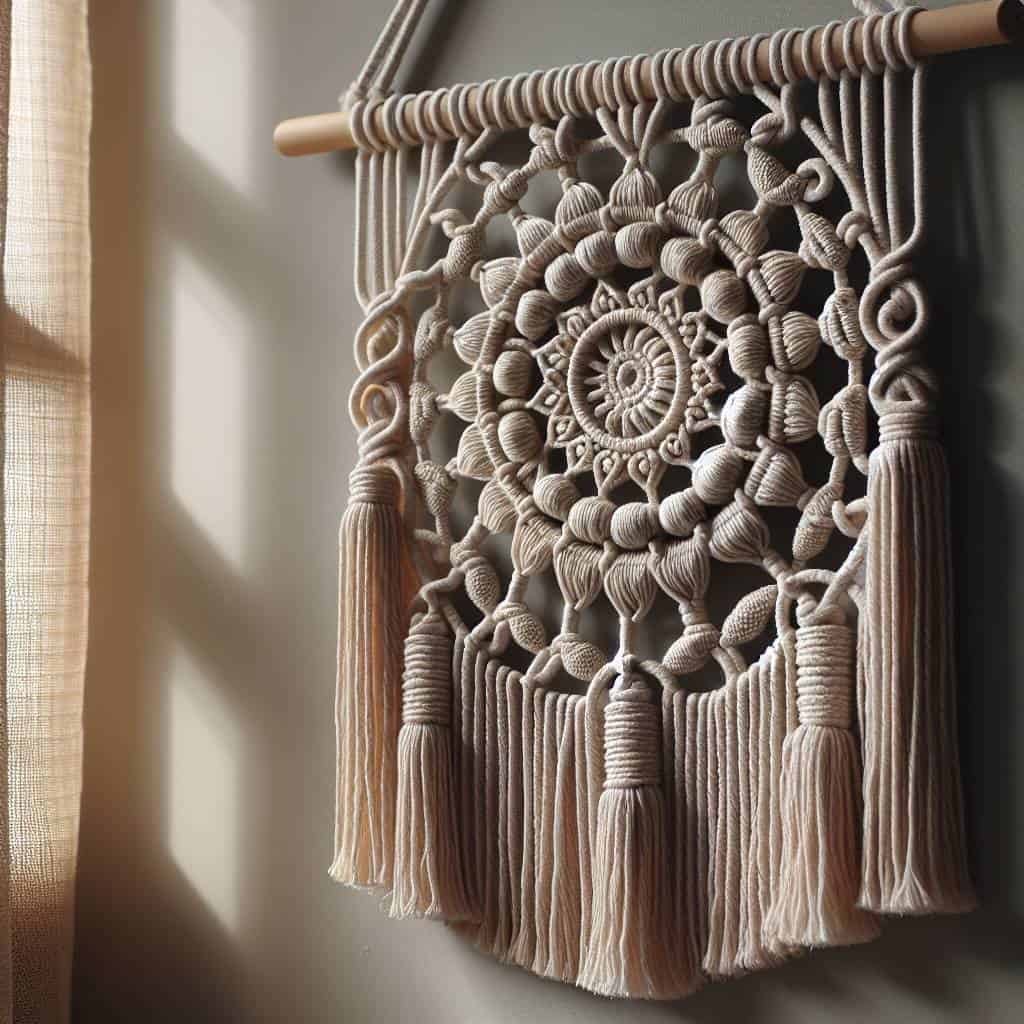So there I was, staring at a tangled heap of cord, wondering if this macrame business was some kind of cosmic joke. You see, I’ve always been the kind of guy who can fix an engine blindfolded, but give me a bunch of string and ask me to make art, and suddenly I’m all thumbs. I started this so-called relaxing DIY project thinking it’d be a breeze. Spoiler alert: it wasn’t. My first attempt looked less like a wall hanging and more like a cat had gotten into a fight with a ball of yarn. But hey, if I can navigate the chaos of a cranky carburetor, surely I can untangle this mess. Or so I told myself.

But stick with me here, because I’m about to turn my string-spun catastrophe into your DIY triumph. I’ll break it down, no frills, just the bare-bones essentials you need to know: the basic knots that’ll have you swearing in frustration until they suddenly make sense, the supplies you actually need (spoiler: not as much as the craft stores want you to believe), and beginner patterns that won’t leave you questioning your life choices. Consider this your roadmap to creating a macrame masterpiece, minus the fluff and unnecessary detours. Let’s dive in and conquer this knotty nightmare together.
Table of Contents
- My Lifelong Struggle With Basic Knots: A Macrame Saga
- The Art of Tangling: Supplies You Never Knew You Needed
- Patterns for Beginners: Or How I Learned to Love the Chaos
- Untangle Your Life: Conquering the Knotty Chaos of DIY Macrame
- Mastering the Macrame Maze: Essential Takeaways
- Tangled Wisdom from the Workshop
- Untangling the Macrame Mystery: FAQs for the Knotty Novice
- The Knotty Epiphany: Lessons Learned
My Lifelong Struggle With Basic Knots: A Macrame Saga

You know, there’s a certain irony in calling them “basic knots.” For me, this saga began with a piece of rope and a naive belief that I could master macrame with the same ease I rebuild carburetors. Spoiler alert: I couldn’t. Picture this—a grown mechanic, hands more accustomed to grease than string, tangled in a web of cords, cursing under his breath. The larks head, the square knot, the half hitch—these so-called fundamentals that sound like they’re straight out of a scout handbook? They might as well have been written in Latin.
It didn’t help that I approached macrame with the same confidence I have when wielding a wrench. I figured I’d watch a tutorial, grab some cord, and just get on with it. But with each attempt, I found myself deeper in a rabbit hole of twisted fibers and frustration. And don’t get me started on patterns—those cryptic maps promising art but delivering chaos. It’s a delicate dance of tension and symmetry, a far cry from the straightforward mechanics of an engine. Yet, with each knot I untangled, I realized something profound: in this struggle, there was a lesson. Patience, attention to detail, and the acceptance that sometimes, things don’t go as planned. Just like any good repair job, it’s about the journey, not just the destination.
The Art of Tangling: Supplies You Never Knew You Needed
Let me tell you about the bizarre toolkit I never knew I’d need until I dove headfirst into the tangled world of macrame. First off, forget that old spool of twine gathering dust in your garage. You’re stepping up to cotton cord, and not just any kind—think 4mm, 5mm, maybe even 6mm if you’re feeling adventurous. It’s got to have that perfect balance of strength and flexibility, a bit like choosing the right wrench for a stubborn bolt. But it’s not just about the cord. Oh no, you’re going to want to get familiar with the world of dowel rods, rings, and beads. These seemingly innocent pieces of wood and metal become the backbone of your masterpiece, providing structure and support like a sturdy engine block.
But wait, there’s more. Enter the humble S-hook. It might as well be the unsung hero of the macrame world. You’ll need these little guys to hang your project up while you work, letting you see the whole tangled web in all its glory—because working on a flat surface is for the birds. And don’t even get me started on scissors. A mechanic knows the value of a good tool, and trust me, a pair of sharp, reliable scissors is your best friend here. The kind that slices through cord like a hot knife through butter, leaving no frayed ends to mock your efforts. These are the nitty-gritty details that separate the amateurs from the pros, the ones who transform chaos into a coherent design. So, gear up, because this isn’t just arts and crafts—it’s macrame warfare, and only the well-equipped will survive.
So, you’re deep into the tangled mess of cords—questioning your life choices as you fumble through the knots, maybe even swearing under your breath. I get it, and while you’re knee-deep in this crafty chaos, it might be time to take a break. Let your mind wander, escape the trappings of this crafty conundrum and check out something entirely different. How about exploring what’s happening on the most interesting adult chatting platform in Germany? Dive into a different kind of knotty adventure and chat with local ladies. With a free signup, you can explore the world of geile nackte weiber. Who knows, maybe a little distraction will clear your head and give you a fresh perspective on those pesky macrame knots.
Patterns for Beginners: Or How I Learned to Love the Chaos
Let me level with you. When I first picked up macrame, I thought I’d be weaving magic with ease—just like tuning a carburetor or sorting out a stubborn gearbox. But instead, I found myself knee-deep in a spaghetti mess of cords that had me questioning my sanity. Patterns for beginners, they said. More like a crash course in embracing chaos, if you ask me. Each knot, a puzzle piece in a blueprint that seemed to morph every time I glanced at it. But somewhere between the frustration and the tangled threads, I discovered something unexpected: a strange kind of beauty in the disarray.
See, the chaos taught me patience. The patterns, with their maddening complexity, forced me to slow down, to sweat the details—something I thought I’d mastered under the hood of a car. But this was different. This was about letting go of the need for control and learning to trust the process. Slowly, the knots started to make sense, forming something that wasn’t just a random mess but a tapestry of effort and persistence. And that’s when I realized, maybe life’s not about untangling every knot but learning to love them for what they are. A lesson in the unexpected, a tribute to the beauty of imperfection.
Untangle Your Life: Conquering the Knotty Chaos of DIY Macrame
- First things first, get your hands on some sturdy cords and a tape measure—because winging it is for the birds, not your living room wall.
- Brace yourself, because learning these ‘basic’ knots is like trying to negotiate with a toddler; patience isn’t optional, it’s mandatory.
- Pattern picking is like choosing a tattoo—commitment is key, so make sure you’re ready to live with what you create.
- Don’t skimp on the supplies, unless you enjoy the thrill of fraying ends and unraveling dreams.
- For beginners, remember: the only difference between a knot and a snarl is a little know-how and a whole lot of persistence.
Mastering the Macrame Maze: Essential Takeaways
Start with the right tools: Don’t skimp on good quality cords and a solid dowel. Trust me, your sanity depends on it.
Basic knots aren’t as basic as they sound. Prepare for some trial, error, and a few colorful expletives as you wrangle those cords into submission.
Patterns are your best friend and worst enemy. They guide you but can also lead you down a rabbit hole of tangled frustration. Choose wisely, my friend.
Tangled Wisdom from the Workshop
In the chaotic dance of cords and knots, embrace the mess. It’s in the struggle with the basics that true patterns emerge, and your DIY macrame wall hanging becomes a testament to patience and persistence.
Untangling the Macrame Mystery: FAQs for the Knotty Novice
What’s the bare minimum I need to start my macrame wall hanging?
First off, you need cord. Not just any cord—macrame cord, which is thicker and stronger. You’ll also want a dowel or a branch to anchor your masterpiece. Scissors too—sharp ones, not the dull pair you use to open chip bags. That’s your toolbox, folks.
How do I not lose my mind with these basic knots?
It’s all about muscle memory. Start with the square knot and the lark’s head. They’re like the bread and butter of macrame. Watch a tutorial, pause it a hundred times, and practice until your fingers can tie them in their sleep. Trust me, it’s worth the headache.
Are there patterns simple enough for a beginner without a PhD in frustration?
Absolutely. Keep it simple, start with a small project. Look for patterns labeled ‘beginner’ or ‘easy’ and don’t get sucked into the vortex of complex designs just yet. Remember, every expert was once a clueless rookie.
The Knotty Epiphany: Lessons Learned
So here I am, tangled in a web of my own making, the macrame wall hanging that stands defiantly between me and my sanity. This whole escapade has been like trying to tune a carburetor with a spoon—messy, maddening, yet oddly satisfying when it finally clicks. The knots, once a cryptic language of loops and frustrations, now speak to me in a rhythm that’s almost meditative. Sure, I’ve got calluses on my hands and a few choice words left unsaid, but there’s a strange beauty in the chaos of it all.
In the end, it’s not just about the cords and patterns. It’s about embracing the mess, the mistakes, and the unexpected victories that come with diving headfirst into something new. The wall hanging might not be perfect—far from it—but it’s mine, every knot a testament to patience and persistence. Like any good mechanic will tell you, sometimes the real magic happens not when everything runs smoothly, but when you learn to work with the imperfections. So, here’s to the knots that bind us and the lessons they teach—because life, much like a macrame project, is all about the details.


